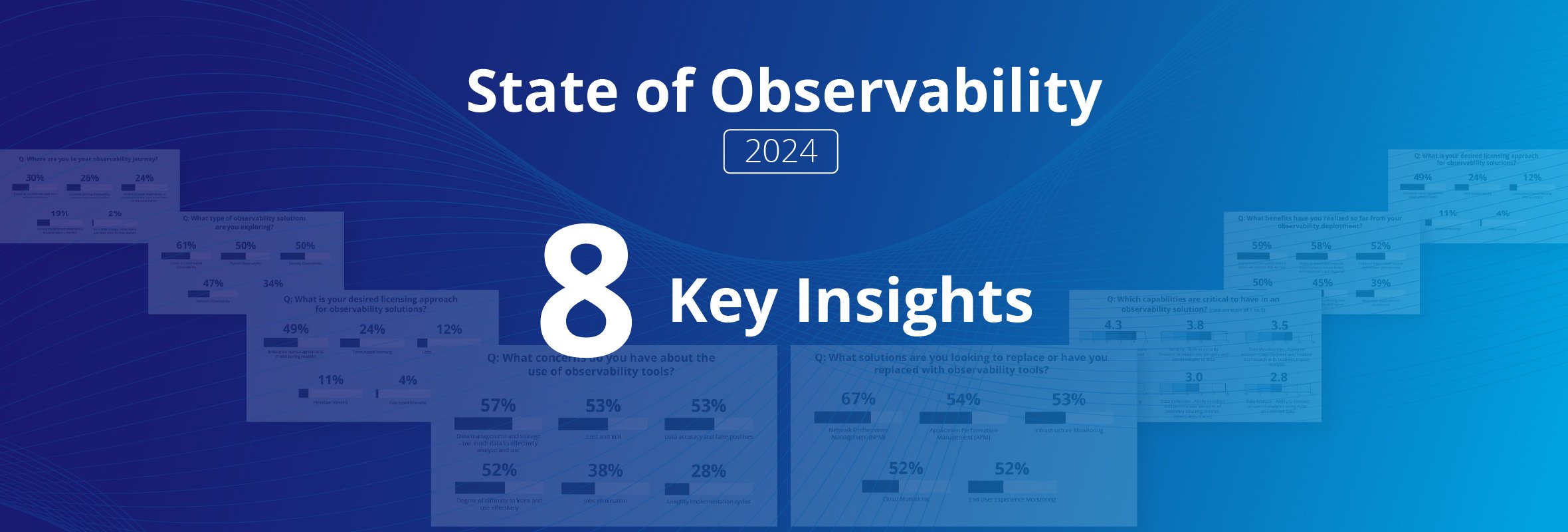The OpsRamp State of Observability 2024 report not only presents fascinating data from a strong sample of IT leaders, but also outlines many highly actionable findings. As an independent analyst and advisor, I appreciate how this report outlines a powerful action plan for any CIO, CTO, or other IT leader who has not yet adopted or achieved success with observability.
While the whole report contains a wealth of new and interesting data, with a raft of deeply insightful analysis and commentary, some of its key findings that I am now using to advise my clients include:
- The time for observability is now. With only 24% of respondents running a unified, full-stack observability solution, this research is both surprising and challenging. For most IT leaders the journey to observability is just beginning, but the barriers to success are increasingly avoidable with 20/20 hindsight. Moreover, there are more observability options than ever, including many new and innovative solutions. There could not be a better time to embark on an observability journey.

- Start with cloud-native services. With 61% of respondents adopting observability for cloud-native services, this study highlights this area as a strong candidate for early success. Cloud-native applications are often complex and distributed systems that produce monitoring data volumes that quickly overwhelm traditional teams and tools. Unlike older approaches like APM, observability is designed specifically for these new, massively scalable, mission-critical, custom-built systems.

- Choose predictable pricing. With only 12% of respondents opting for variable consumption-based pricing, data ingestion has never been a more unpopular cost model. IT leaders needing predictable costs for full-fidelity monitoring with high cardinality and ‘no sampling’ – and limited potential for a career-limiting budget overrun – should join the 49% of leaders opting for enterprise-wide ‘all you can eat’ licensing, or per user licensing, and avoid the possibility (or likelihood!) of an unexpected $65m [vendor-redacted] bill landing on the CFO’s desk.

- Beware other cost drivers. Unsurprisingly, 53% of IT leaders cite concerns for managing cost and delivering ROI, but while software licensing is a significant cost driver, leaders also cite long deployment times, data management and storage costs, skills training and availability, and other ongoing costs as major risks to ROI. IT leaders adopting observability should look to mitigate these ongoing costs with solutions that are easy to deploy, easy to use, with an ecosystem of training partners and data integrations, and more efficient data storage and management capabilities.

- Re-evaluate your monitoring estate. While ROI is justifiably a key concern, 45% of respondents report adopting observability also allowed them to retire legacy tools and/or reduce IT spending. This research gives good insight on where to start too, in findings that over two-thirds of respondents replaced network performance monitoring (NPM) tools; and over half replaced application performance management (APM) and IT infrastructure monitoring (ITIM) tools.

- Do not throw the baby out with the bathwater. Importantly, observability cannot always replace traditional monitoring tools, and is often improved by maintaining and integrating traditional data sources. Only 27% of IT leaders surveyed were able to replace end user or real user monitoring (EUM/RUM) tools. Many older, off-the-shelf, or client-server applications were not built to be observable, but need legacy tools to provide observability data. IT leaders should expect to keep and integrate some traditional tools, especially for these non-cloud-native applications.
- Face your challenges head-on. This study provides clear guidance on mitigating top challenges to success. Buyers should look for key capabilities including ‘seamless’ integration with extant data sources; user and data security models aligned with corporate tools and policies; enhanced visualizations that connect observability data with business context; real time monitoring and alerting; and integrations with IT process automation, AIOps, and other IT operations workflows and solutions.

- The risk/reward payoff is worth it. Despite a slow start and apparent challenges, this study shows observability is still delivering compelling results, with a clear majority reporting significant benefits. Get past the costs and risks, and observability will help uncover hidden performance issues, thwart cybersecurity attacks, improve service quality, and detect (and even predict or prevent) application errors, outages, and slowdowns, before they become customer issues.

Which brings us full circle. For any CIO or CTO who has not started, now is the best time to adopt observability. You are not too far behind your peers – but you are missing out on significant business results. Even better, you can learn from their mistakes, and especially with this research you can better understand their key decision factors in selecting a superior observability solution; top drivers for delivering real ROI; and the many realistic objectives and key results for delivering cost reduction, service resilience, customer satisfaction, and other business and IT benefits.
Next Steps:
- Watch Andi Mann discuss the State of Observability survey results with OpsRamp experts on the State of Observability 2024 On-Demand Webinar.
- Read the Blog: Is it Still Early Days for Observability?
- Read the Blog: Why the Early Results of Observability Look so Promising
- Read the Blog: And the Killer App for Observability is...Integrations
- Read the Blog: OpsRamp and the Rise of Observability
- Follow OpsRamp on X and LinkedIn for real-time updates and news from the world of IT operations.
- Schedule a custom demo with an OpsRamp solution expert.



